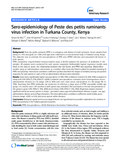Sero-epidemiology of Peste des petits ruminants virus infection in Turkana County, Kenya

View/
Date
2015-04-08Author
Kihu, Simon M
Gachohi, John M
Ndungu, Eunice K
Gitao, George C
Bebora, Lily C
John, Njenga M
Wairire, Gidraph G
Maingi, Ndichu
Wahome, Raphael G
Ireri, Ricky
Type
Journal ArticleMetadata
Show full item recordAbstract
Abstract
Background
Peste des petits ruminants (PPR) is a contagious viral disease of small ruminants. Serum samples from sheep (n = 431) and goats (n = 538) of all ages were collected in a cross-sectional study in Turkana County, Kenya. The objective was to estimate the sero-prevalence of PPR virus (PPRV) infection and associated risk factors in both species.
PPRV competitive enzyme-linked immuno-sorbent assay (c-ELISA) analysed the presence of antibodies in the samples. All analyses were conducted for each species separately. Multivariable logistic regression models were fitted to the data to assess the relationship between the risk factors and PPRV sero-positivity. Mixed-effect models using an administrative sub-location as a random effect were also fitted to adjust for possible clustering of PPRV sero-positivity. Intra-cluster correlation coefficients (ρ) that described the degree of similarity among sero-positive responses for each species in each of the six administrative divisions were estimated.
Results
Goats had a significantly higher sero-prevalence of 40% [95% confidence interval (CI): 36%, 44%] compared to sheep with 32% [95% CI: 27%, 36%] (P = 0.008). Combined sero-prevalence estimates were heterogeneous across administrative divisions (n = 6) (range 22% to 65%) and even more across sub-locations (n = 46) (range 0% to 78%). Assuming that PPRV antibodies are protective of infection, a large pool of PPRV susceptible middle age group (>6 months and < 24 months) in both species was estimated. This was based on the low sero-prevalence in this group in goats (14% [95% CI: 10%, 20%]) and in sheep (18% [95% CI: 13%, 25%]). Regression analysis returned significant risk factors across species: in sheep - vaccination status, age and administrative division; in goats - sex, age, administrative division and sex*age interaction. The intra-sub-location correlation coefficients varied widely across divisions (range <0.001 to 0.42) and across species within divisions.
Conclusions
Biological, spatial and socio-ecological factors are hypothesized as possible explanations for variation in PPRV sero-positivity in the Turkana pastoral ecosystem.
